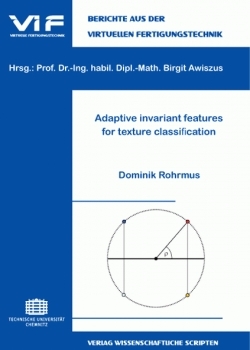|
→ Inhaltsverzeichnis  → Leseprobe → Leseprobe 
Birgit Awiszus (Hrsg.)
Dissertation Dominik Rohrmus
Berichte aus der Virtuellen Fertigungstechnik, VIF Bd. 7
Adaptive invariant features for texture classification
168 Seiten, 61 Abbildungen, A5, Broschur
ISBN: 9783942267755
Verlag Wissenschaftliche Scripten
Die Qualität vieler industrieller Produkte wird durch deren Oberfläche bestimmt. Anforderungen der modernen, variantenreichen Serienproduktion an Qualität und Produktivität erfordern zunehmend eine automatisierte und flexible Qualitätskontrolle der Muster von Oberflächen, genannt Texturen. In dieser Arbeit wird eine Methode zur Extraktion und Klassifikation von invarianten Texturmerkmalen aus Grauwertkamerabildern entwickelt, welche rotatorische und translatorische Lageunabhängigkeit der Produkte in der Bildebene ermöglicht. Die Texturanpassungsfähigkeit der aus der Methode resultierenden Prüftechnologie erhöht die Variantenflexibilität, gewährleistet Ergebnisreproduzierbarkeit und birgt ein großes betriebswirtschaftliches Potenzial durch eine breite Anwendbarkeit. Diese Effekte werden mittels Optimierung der Merkmalsparameter während einer Trainingsphase erzielt. Die lagerobuste Texturanalyse wird durch die invariante Integration in kleinen Bildregionen über die Rotationsgruppe und das anschließende Eintragen aller Rotationsmerkmalsergebnisse in ein Histogramm pro Region erreicht. Dazu werden drei neue Klassen von Integrationskernen mit freien Parametern eingeführt. Diese Kerne erfassen die Textureigenschaften.
Zusätzlich werden neue Kerne entwickelt, welche die Anisotropie der Textur einbeziehen. Diese fangen Orientierungen und die Periodizität der Struktur in kleinen Bildausschnitten ein. Die freien Kern- und Anisotropieparameter werden im Sinne der maximalen Texturunterscheidungsfähigkeit mit Hilfe des Fisher-Kriteriums während einer überwachten Trainingsphase optimiert, welche auf gekennzeichneten Bildern beruht. Die durchgeführten Experimente zeigen verbesserte Klassifikationsgenauigkeit gegenüber den klassischen isotropen, monomialen Merkmalskernen sowohl für die Texturklassifikation mit den Brodatz, MeasTex und VisTex Datensätzen, als auch für die Defektklassifikation mit dem TILDA Textildatensatz. Es wurden starke Verbindungen zwischen den Merkmalskernen und den Anisotropieeinstellungen im Bezug auf verschiedene Arten von Texturen, der Texturunterscheidungsfähigkeit und der Klassifikationsleistung gefunden und diskutiert.
The quality of many industrial products is defined by their surfaces. Requirements on the quality as well as productivity of modern series production facing a high degree of product variants increasingly ask for automated and flexible quality inspection solutions for the patterns of surfaces, called textures. In this work a method for the extraction and classification of invariant texture features is developed, which allows for rotation and translation invariant positioning of the products in the camera plane. The texture adaptability of the inspection technology resulting from this method increases the product variants flexibility, ensures the results reproducibility and thus, is of great economic relevance due to the broad applicability. These effects are realized by the optimization of the feature parameters during a training phase. The position–robust texture analysis is accomplished by the invariant integration in small image regions over the rotation group and the insertion of the resulting rotation features in one histogram per region. Therefore, three novel classes of integration kernels with free parameters are introduced. The kernels capture the texture characteristics.
Additionally, novel kernels are developed that acquire the anisotropy of the texture. They capture the orientations and the periodicity of the underlying structures in the image region. The free kernel and anisotropy parameters are optimized with respect to maximum texture discrimination using the Fisher criterion during a supervised training phase, which is based on marked and labeled image samples. The conducted experiments show improved classification accuracy compared to the classical isotropic monomial feature kernels for texture classification with the Brodatz, MeasTex, and VisTex data sets as well as defect classification with the TILDA textile data set. Strong relationships of the feature kernels and the anisotropy settings to certain types of textures, to the texture discrimination, and to the texture classification performance are found and discussed.
|
